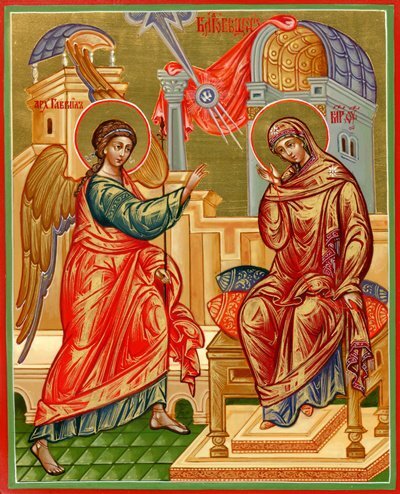Annunciation Day: Hail, favored one! The Lord is with you
Report by Elia Nasrallah
“Behold, I am the handmaid of the Lord. May it be done to me according to your word.” (Luke 1:38). With these words the Virgin Mary put a start to the history of mankind and Christianity. Had it not been for her obedience to God, there wouldn’t have been a union between the divine and the human nature. The Annunciation came as the start of the path of salvation for mankind and all Christian doctrines, in which the Virgin Mary prepared for the birth of the Savior and the Redeemer by accepting this divine call and, thus, setting in place the divine ecclesiastical plan.
It is true that the divine conception of the Virgin Mary in Nazareth and the incarnation of God in her womb drove humanity to ask many questions, but it is one of the greatest and few Christian holidays uniting the Orthodox and Catholic families for they celebrate it together on March 25 of each year. The Coptic Orthodox Church, however, celebrates it on April 7.
In Lebanon, this holiday is special since it became a common national day between Christians and Muslims. The Lebanese Cabinet decided to turn it into a collective day to honor the Virgin Mary, Mother of God the Savior and Mother of all mankind. This holiday comes in the midst of a sea of crises with an uncertain fate, burdening Lebanon and the Middle East. Perhaps it is the beginning of a long-awaited salvation to middle-eastern people who suffered and are still suffering over the years from conflicts and division...
The Annunciation in the early Church was not an independent holiday as it was related to Christmas, which, in turn, was related to the Divine Appearance. Changes occurred in the fifth century AD, as Christmas began to become an independent holiday. It was a matter of time before allocating a date for the Annunciation to be celebrated with prayers and readings with a direct correlation to the concept and theology of the holiday. Coinciding with the first days of spring and the equal hours of night and day, the 25th of March has become a date devoted to the Annunciation since ancient civilizations considered that God created the world and humanity on this day.
Saint Anastasius of Antioch (599 AD) wrote on this subject, he says: “With wisdom, God created everything. In order and justice, he created life and opened time. He wanted to come to us during the same period. Spring starts on March 20... the sixth day on which God created man would be March 25. On this day, God and man are completely united.” St. Maximus the Confessor (622 AD) talks about the time and place of the Annunciation: “The Virgin lived in fast and went to the source on foot to pray because she found God, the source of her life."
The “divine conception” and “God's becoming man through birth” were among the most prominent themes and faith confessions told by many Christian groups before the conclusion of the Church's Faith Constitution during the First Ecumenical Council in Nicaea in 325AD, and its follow-up at the Second Ecumenical Council in Constantinople in 381AD. The Annunciation is considered the basis of the Christian faith, saying otherwise would be heresy to Christianity. The seven Ecumenical Councils that took place in the first millennium confirmed the incarnation and birth of God from the Holy Spirit and the Virgin Mary.
Tertullian (230/220 A.D.) compares in his writings “The Body of Christ” Eve and the Mother of God during the Annunciation. He explains how Eve ignored the word of God by listening to the serpent, thus, the word of Satan, and this is why she perished. Mary, however, listened to the word of God by listening to his angel Gabriel, and she rose. Believing Satan led Eve and mankind to torment and death, while the word of God brought forth a new life with Jesus Christ, Bread of life.
In the Annunciation icon of the Mother of God, the angel Gabriel, conveying the good news, appears before the Virgin, who looks at him with amazement, fascination and innocence, wondering how this could be since she had no relations with a man. The Virgin’s hand indicates her obedience to the will of God “May it be done to me according to your word” (Luke 1:38). The brown color of her clothes means that she is human, made of clay, just like us, waiting for salvation, saying: “My soul proclaims the greatness of the Lord; my spirit rejoices in God my savior.” (Luke 1:46-47). A ray of light falls from the top of the icon, symbolizing the Holy Spirit descending into the womb of the Virgin Mary. The buildings in the background of the icon symbolize the temple that witnessed the pure upbringing of the girl who represents the Old Testament, while the other buildings refer to the New Testament. As for the red scarf, it connects the two Testaments and means that we were brought, with the Mother of God, from the old to the new.
Communication and Public Relations Department
Sources:
Greek Orthodox Patriarchate of Antioch and All the East website: https://bit.ly/31bPdst
Al Siraj Al Orthodoxy website: https://bit.ly/396q3jB
Watani Net website: https://bit.ly/3sdT8RB


